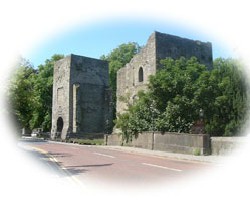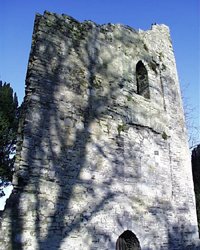County Kildare History and Heritage
Maynooth Castle, County Kildare
Maynooth Castle is now run by the Office of Public Works.
An exhibition on the history of the Fitzgerald family and the castle is housed in the visitor centre on site. Admission is free and guided tours are available.
Maynooth Castle opening times for 2007 are
June-September: Monday to Sunday 10am-6pm,
October: Sundays and Bank Holidays 10am-5pm.
For further information please contact 00 353 1 6286744 or maynoothcastle@opw.ie
 The ancient name of Maynooth ‘Magh Nuadhat’ means
the plain of Nuadhat. Nuadhat is referred to as the maternal grandfather
of the legendary Fionn MaCumhail in the ‘Annals of the Four Masters’.
In 1426 the sixth Earl of Kildare enlarged and rebuilt the castle. In
the latter half of the fifteenth century, Maynooth Castle became the
centre of the Geraldine powerbase, as the Earls of Kildare increased
their strength of ‘rule’. This was something which the English
monarchy disliked. The
culmination of the developing friction between the Fitzgeralds
and the monarchy was the rebellion of Silken Thomas (so called because
of his fine clothes).
The ancient name of Maynooth ‘Magh Nuadhat’ means
the plain of Nuadhat. Nuadhat is referred to as the maternal grandfather
of the legendary Fionn MaCumhail in the ‘Annals of the Four Masters’.
In 1426 the sixth Earl of Kildare enlarged and rebuilt the castle. In
the latter half of the fifteenth century, Maynooth Castle became the
centre of the Geraldine powerbase, as the Earls of Kildare increased
their strength of ‘rule’. This was something which the English
monarchy disliked. The
culmination of the developing friction between the Fitzgeralds
and the monarchy was the rebellion of Silken Thomas (so called because
of his fine clothes).
 Silken Thomas alias Lord Offaly was a son of Garret Óg,
the ninth Earl of Kildare. Thomas rose up in rebellion against the king
who had arrested his father, and held him in the Tower of London. Thomas
marched to Dublin Castle and threw down the sword of state, declaring
himself an enemy of the king. However, his rebellion was curbed when
he and his followers were defeated and the stronghold of Maynooth taken
by the English. All those within the castle were put to death and this
became known, ironically, as the ‘Maynooth Pardon’. Thomas,
along with five of his uncles, was later executed in London. Maynooth
Castle then became a royal castle and a popular residence for the Lord
Deputies of Ireland.By the seventeenth century however, the castle had
fallen derelict. It became the property of the Duke of Leinster and
today only the ruined keep and the gate-house survive.
Silken Thomas alias Lord Offaly was a son of Garret Óg,
the ninth Earl of Kildare. Thomas rose up in rebellion against the king
who had arrested his father, and held him in the Tower of London. Thomas
marched to Dublin Castle and threw down the sword of state, declaring
himself an enemy of the king. However, his rebellion was curbed when
he and his followers were defeated and the stronghold of Maynooth taken
by the English. All those within the castle were put to death and this
became known, ironically, as the ‘Maynooth Pardon’. Thomas,
along with five of his uncles, was later executed in London. Maynooth
Castle then became a royal castle and a popular residence for the Lord
Deputies of Ireland.By the seventeenth century however, the castle had
fallen derelict. It became the property of the Duke of Leinster and
today only the ruined keep and the gate-house survive.
It provides an impressive entrance for Maynooth College, which was founded in 1795 and is famous for the education of the Irish Catholic priests.

